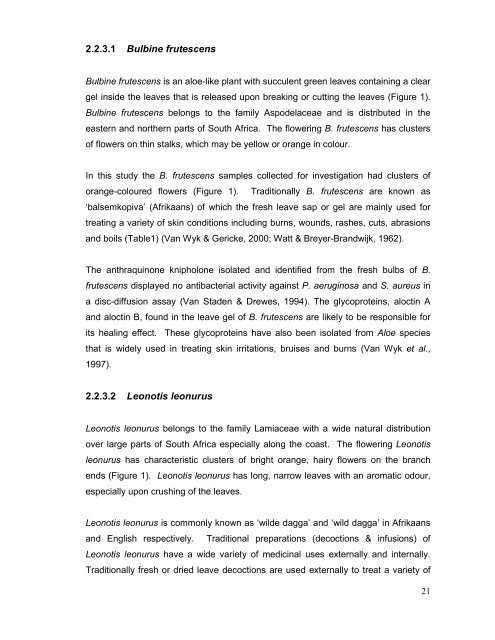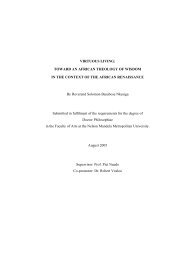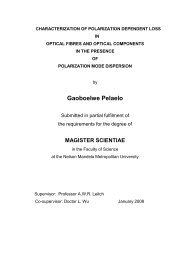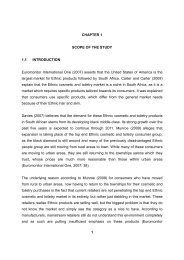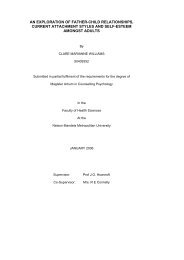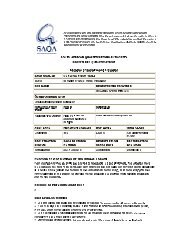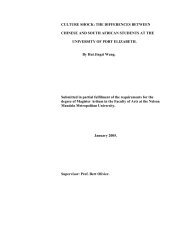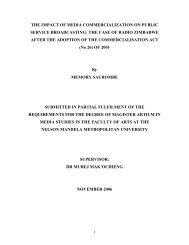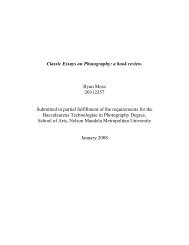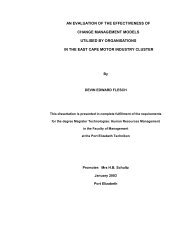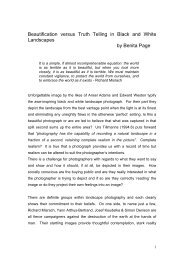an investigation into the antibacterial activities of medicinal plants ...
an investigation into the antibacterial activities of medicinal plants ...
an investigation into the antibacterial activities of medicinal plants ...
You also want an ePaper? Increase the reach of your titles
YUMPU automatically turns print PDFs into web optimized ePapers that Google loves.
2.2.3.1 Bulbine frutescens<br />
Bulbine frutescens is <strong>an</strong> aloe-like pl<strong>an</strong>t with succulent green leaves containing a clear<br />
gel inside <strong>the</strong> leaves that is released upon breaking or cutting <strong>the</strong> leaves (Figure 1).<br />
Bulbine frutescens belongs to <strong>the</strong> family Aspodelaceae <strong>an</strong>d is distributed in <strong>the</strong><br />
eastern <strong>an</strong>d nor<strong>the</strong>rn parts <strong>of</strong> South Africa. The flowering B. frutescens has clusters<br />
<strong>of</strong> flowers on thin stalks, which may be yellow or or<strong>an</strong>ge in colour.<br />
In this study <strong>the</strong> B. frutescens samples collected for <strong>investigation</strong> had clusters <strong>of</strong><br />
or<strong>an</strong>ge-coloured flowers (Figure 1). Traditionally B. frutescens are known as<br />
‘balsemkopiva’ (Afrika<strong>an</strong>s) <strong>of</strong> which <strong>the</strong> fresh leave sap or gel are mainly used for<br />
treating a variety <strong>of</strong> skin conditions including burns, wounds, rashes, cuts, abrasions<br />
<strong>an</strong>d boils (Table1) (V<strong>an</strong> Wyk & Gericke, 2000; Watt & Breyer-Br<strong>an</strong>dwijk, 1962).<br />
The <strong>an</strong>thraquinone knipholone isolated <strong>an</strong>d identified from <strong>the</strong> fresh bulbs <strong>of</strong> B.<br />
frutescens displayed no <strong>an</strong>tibacterial activity against P. aeruginosa <strong>an</strong>d S. aureus in<br />
a disc-diffusion assay (V<strong>an</strong> Staden & Drewes, 1994). The glycoproteins, aloctin A<br />
<strong>an</strong>d aloctin B, found in <strong>the</strong> leave gel <strong>of</strong> B. frutescens are likely to be responsible for<br />
its healing effect. These glycoproteins have also been isolated from Aloe species<br />
that is widely used in treating skin irritations, bruises <strong>an</strong>d burns (V<strong>an</strong> Wyk et al.,<br />
1997).<br />
2.2.3.2 Leonotis leonurus<br />
Leonotis leonurus belongs to <strong>the</strong> family Lamiaceae with a wide natural distribution<br />
over large parts <strong>of</strong> South Africa especially along <strong>the</strong> coast. The flowering Leonotis<br />
leonurus has characteristic clusters <strong>of</strong> bright or<strong>an</strong>ge, hairy flowers on <strong>the</strong> br<strong>an</strong>ch<br />
ends (Figure 1). Leonotis leonurus has long, narrow leaves with <strong>an</strong> aromatic odour,<br />
especially upon crushing <strong>of</strong> <strong>the</strong> leaves.<br />
Leonotis leonurus is commonly known as ‘wilde dagga’ <strong>an</strong>d ‘wild dagga’ in Afrika<strong>an</strong>s<br />
<strong>an</strong>d English respectively. Traditional preparations (decoctions & infusions) <strong>of</strong><br />
Leonotis leonurus have a wide variety <strong>of</strong> <strong>medicinal</strong> uses externally <strong>an</strong>d internally.<br />
Traditionally fresh or dried leave decoctions are used externally to treat a variety <strong>of</strong><br />
21


